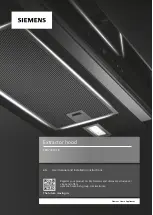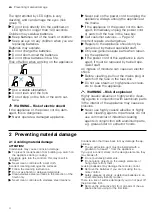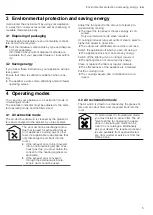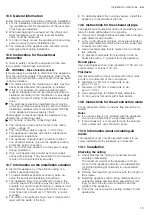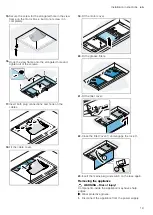
Installation instructions
en
15
13.5 General information
Follow these general instructions during the installation.
¡
For the installation, observe the currently valid build-
ing regulations and the regulations of the local elec-
tricity and gas suppliers.
¡
When discharging the exhaust air, the official and
legal regulations, such as the regional building
code., must be observed.
¡
In order to freely access the appliance for servicing,
select an easy-to-reach installation site.
¡
The surfaces of the appliance are sensitive. Avoid
damaging them during installation.
13.6 Instructions for the electrical
connection
In order to safely connect the appliance to the elec-
trical system, follow these instructions.
WARNING ‒ Risk of electric shock!
It must always be possible to disconnect the appliance
from the electricity supply. The appliance must only be
connected to a protective contact socket that has been
correctly installed.
▶
The mains plug for the mains power cable must be
easily accessible after the appliance is installed.
▶
If this is not possible, an all-pole isolating switch
must be integrated into the permanent electrical in-
stallation according to the conditions of overvoltage
category III and according to the installation regula-
tions.
▶
The permanent electrical installation must only be
wired by a professional electrician. We recommend
installing a residual-current circuit breaker (RCCB)
in the appliance's power supply circuit.
Sharp-edged components inside the appliance may
damage the connecting cable.
▶
Do not kink or trap the connecting cable.
¡
The connection data can be found on the rating
plate.
¡
The connecting cable is approx. 1.30 m long.
¡
This appliance complies with the EC interference
suppression regulations.
¡
The appliance corresponds to protection class 1.
You should therefore only use the appliance with a
protective earth connection.
¡
Do not connect the appliance to the power supply
during installation.
¡
Only a licensed professional may connect appli-
ances without plugs. They are subject to the require-
ments of the local electricity provider.
13.7 Information on the installation situation
¡
Install this appliance on the kitchen ceiling or a
stable suspended ceiling.
¡
To install additional special accessory parts, ob-
serve the enclosed installation instructions.
¡
The appliance finds it more difficult to draw in the
cooking vapours the further away they are from the
hotplate. For optimum performance, a distance of at
least 900 mm for gas hobs and 650 mm for elec-
trical hobs and a maximum of 1500 mm is recom-
mended.
¡
The width of the extractor hood must correspond at
least with the width of the hob.
¡
To optimally detect the cooking vapours, install the
appliance in the middle of the hob.
13.8 Instructions for the exhaust air pipe
The appliance manufacturer does not provide any war-
ranty for faults attributable to the pipeline.
¡
Use a short, straight exhaust air pipe with as large a
pipe diameter as possible.
¡
Long, rough exhaust air pipes, many pipe bends or
small pipe diameters reduce the suction power and
increase the fan noise.
¡
Use an exhaust pipe that is made of non-combust-
ible material.
¡
To prevent condensate from returning, fit the ex-
haust pipe with a 1° gradient from the appliance.
Round pipes
Use round pipes with an inner diameter of 150 mm (re-
commended) or at least 120 mm.
Flat ducts
Use flat ducts with an inner cross-section that corres-
ponds to the diameter of the round pipes:
¡
Diameter of 150 mm corresponds to ap-
prox. 177 cm².
¡
Diameter of 120 mm corresponds to ap-
prox. 113 cm².
¡
Use sealing strips for different pipe diameters.
¡
Do not use any flat ducts with sharp bends.
13.9 Instructions for the air extraction mode
For air extraction mode, a one-way flap should be in-
stalled.
Notes
¡
If a one-way flap is not included with the appliance,
one can be ordered from a specialist retailer.
¡
If the exhaust air is conveyed through the external
wall, a telescopic duct should be used.
13.10 Information about circulating-air
mode
The appliance must only be operated when it is se-
curely installed and the pipework is connected.
13.11 Installation
Checking the ceiling
1.
Check whether the ceiling is horizontal and ad-
equately load-bearing.
The maximum weight of the appliance is 18 kg.
Do not fit the appliance directly onto plasterboard
(or similar lightweight materials) in a suspended
ceiling.
2.
Drill the hole depth in accordance with the length of
the screws.
3.
Install the appliance with a fixing material which is
sufficiently stable and has been adjusted accord-
ingly for both the structural conditions and the
weight of the appliance.
4.
Check the cut-out area for existing cables of other
appliances.

